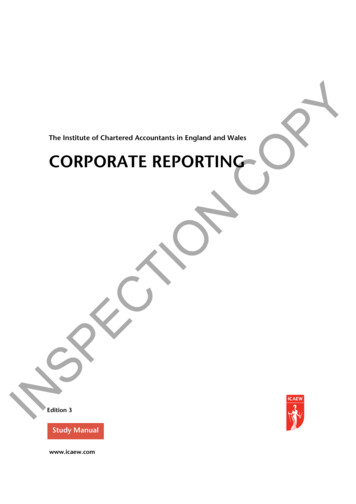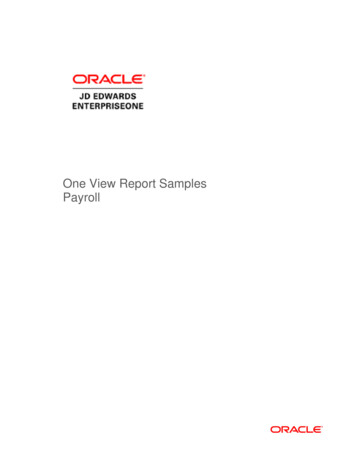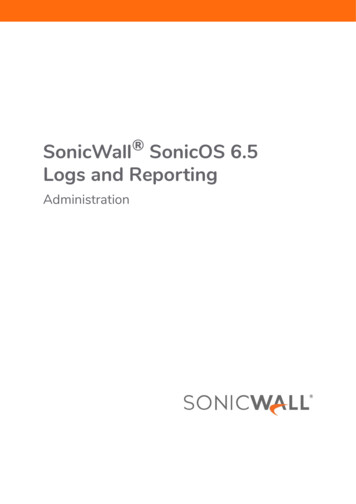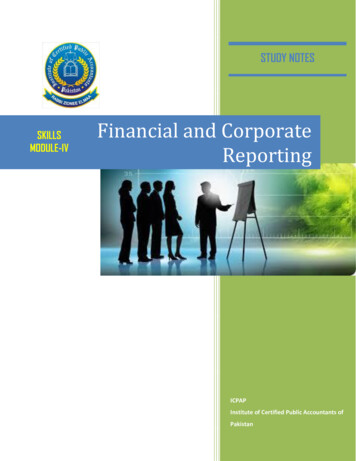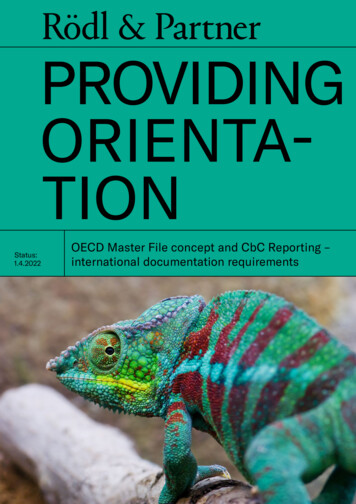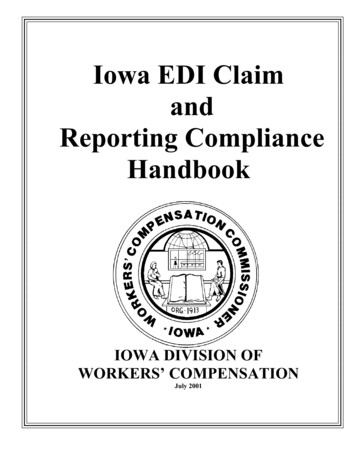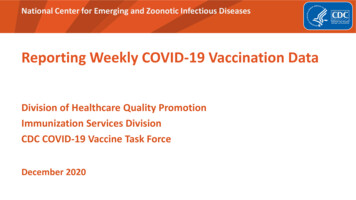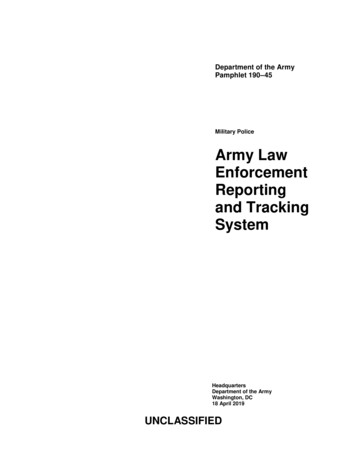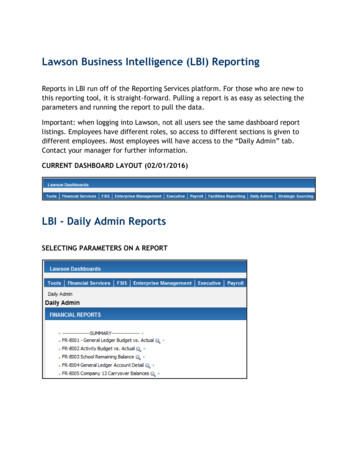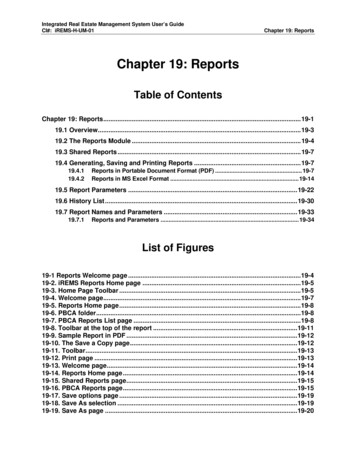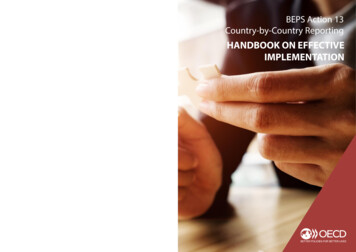
Transcription
Country-by-CountryReportingHandbook on EffectiveImplementationSeptember 2017
This document and any map included herein are without prejudice to the status of orsovereignty over any territory, to the delimitation of international frontiers and boundariesand to the name of any territory, city or area.Please cite this publication as:OECD (2017), Country-by-Country Reporting: Handbook on Effective Implementation, OECD, to credits: Cover MIND AND I – Shutterstock.com OECD 2017You can copy, download or print OECD content for your own use, and you can include excerpts from OECD publications, databases andmultimedia products in your own documents, presentations, blogs, websites and teaching materials, provided that suitableacknowledgment of the source and copyright owner is given. All requests for public or commercial use and translation rights should besubmitted to rights@oecd.org. Requests for permission to photocopy portions of this material for public or commercial use shall beaddressed directly to the Copyright Clearance Center (CCC) at info@copyright.com or the Centre français d'exploitation du droit de copie(CFC) at contact@cfcopies.com.
PREFACE – 3PrefaceNext year will be the first time that tax authorities around the world will receiveinformation on large MNE groups with operations in their country, breaking down agroup's revenue, profits, tax and other attributes by tax jurisdiction. This information hasnever previously been available to tax authorities and represents a great opportunity fortax authorities to understand the structure of a group's business in a way that has not beenpossible before.Country-by-Country Reporting (CbC Reporting) is one of the four minimumstandards of the OECD/G20 Base Erosion and Profit Shifting (BEPS) Project to whichover 100 countries have committed, covering the tax residence jurisdictions of nearly alllarge MNE groups. And the pace of implementation of CbC Reporting is impressive. Asof today, more than 55 jurisdictions have already implemented an obligation for relevantMNEs to file CbC Reports. Jurisdictions have also moved quickly to ensure that CbCRscan be exchanged between tax administrations. To date, 65 jurisdictions have signed theMultilateral Competent Authority Agreement and some jurisdictions have entered intobilateral Competent Authority Agreements to operationalise the exchange of CbCRs withspecific jurisdictions. With nine months to go until the first CbC Reports are exchanged,over 1 000 exchange relationships between pairs of jurisdictions have already beencreated.The onus is now put on tax authorities to develop and implement solutions for thecollection and handling of CbC Reports and to make effective and appropriate use of theinformation they contain. The Canada Revenue Agency, in the context of the OECDForum on Tax Administration, has sponsored work on two new handbooks, to supportcountries in the effective implementation of CbC Reporting and on the use of theinformation contained in CbC Reports for the purposes of tax risk assessment.The Country-by-Country Reporting: Handbook on Effective Implementation is apractical guide to the key elements that countries need to keep in mind when introducingCbC Reporting, including technical issues related to the filing, exchange and use of CbCReports, as well as practical matters that tax authorities will need to deal with.Following implementation of CbC Reporting, a tax authority will then need to startusing the information they receive, either from a group directly or from a foreign taxauthority. The Country-by-Country Reporting: Handbook on Effective Tax RiskAssessment explores how this can be done, taking into account the different approaches totax risk assessment applied in different countries, the types of tax risk indicator that maybe identified using information contained in CbC Reports, and the challenges that may befaced by tax authorities and that they need to be aware of. It shows that CbC Reports canbe a very important tool for the detection and identification of transfer pricing risk andother BEPS-related risk in the hands of a tax administration, used alongside otherinformation that it holds and as a basis for further enquiries, but also raises cautions aboutCOUNTRY-BY-COUNTRY REPORTING - HANDBOOK ON EFFECTIVE IMPLEMENTATION OECD 2017
4 – PREFACEthe risk that simplistic and misleading conclusions may be drawn if CbC Reports are usedin isolation.These two handbooks will provide valuable support to countries introducing CbCReporting and using the information they receive, but we do not see these handbooks aspermanent, static tools. As time passes, tax authorities will gain in experience incollecting, handling and using CbC Reports and each of the handbooks will be updatedperiodically, to ensure that tax authorities in all countries can benefit from thisexperience.Bob HamiltonCommissioner of the Canada Revenue AgencyCOUNTRY-BY-COUNTRY REPORTING - HANDBOOK ON EFFECTIVE IMPLEMENTATION OECD 2017
TABLE OF CONTENTS – 5Table of contentsAbbreviations and acronyms .7Chapter 1 Introduction and background .9A high level overview of CbC Reporting .9The Country-by-Country Reporting: Handbook on Effective Implementation .11Chapter 2 The filing and use of CbC Reports .15Required elements for the filing and use of CbC Reports .15The definition of an MNE group, and which groups are subject to CbC Reporting .15The definition of a reporting entity .16The definition of a reporting fiscal year .16The determination of the first reporting fiscal year .16The format and content of a CbC Report .16The timing for filing CbC Reports .17The appropriate use of CbC Reports .17The confidentiality of CbC Reports .18Optional elements for the filing of CbC Reports .19Surrogate entity filing.19Local filing .20Notification requirements .22Chapter 3 The exchange of CbC Reports.23The CbC multilateral CAA .23Essential elements of the CAAs .24A commitment to exchange CbC Reports .25The timing of exchange .25The use of a common XML schema .25The manner of transmission .26Notification of non-compliance by a reporting entity .26A domestic obligation for the filing of CbC Reports .26Confidentiality and appropriate use .26Notification of non-compliance with the conditions of confidentiality and appropriate use .27Consultations between competent authorities .27Suspension of exchange of CbC Reports .28Coming-into-effect .29Termination .29The importance of ensuring international agreements are in effect when CbC Reporting commences .29Chapter 4 Operational aspects of CbC Reporting .31The filing of CbC Reports.31Identifying entities required to file CbC Reports .31COUNTRY-BY-COUNTRY REPORTING - HANDBOOK ON EFFECTIVE IMPLEMENTATION OECD 2017
6 – TABLE OF CONTENTSReceiving CbC Reports filed by resident entities .32Checking the completeness of CbC Reports and preparing them for exchange .33Imposing sanctions for non-compliance.33The exchange of CbC Reports .34The common transmission system .35Chapter 5 Guidance, stakeholder engagement and training .39Developing a strategy for stakeholder engagement .39Technical guidance.39Engagement and feedback .40Public engagement .40Developing a training programme .41Types of training .42Timing of training .43Centralisation of training responsibilities.43Specific employee groups .43Annex Country-by-Country Reporting: Guidance on the Appropriate Use of InformationContained in Country-by-Country Reports .49Introduction and background .49The meaning of "appropriate use" .50The meaning of "BEPS-related risk".51Consequences of non-compliance with the appropriate use condition .51Appropriate use as a condition to receiving and using CbC Reports .52A commitment by competent authorities to disclose breaches of appropriate use.52A commitment by competent authorities to promptly concede inappropriate adjustments incompetent authority proceedings .53The ability of competent authorities to temporarily suspend exchange of CbC Reports followingconsultation in cases of non-compliance .53Risk of an incorrect tax assessment.53Approaches to ensure the appropriate use of CbCR information .54Do the multilateral and/or bilateral competent authority agreements concerning CbC Reportingsigned by your jurisdiction include the appropriate use of information contained in CbC Reports, asa condition of obtaining and using CbC Reports? .55Does your tax authority have a clear written policy in place governing the use of CbC Reports,including guidance on appropriate use? .56Is this policy effectively communicated to all staff likely to have access to CbC Reports in the courseof their work? .56Is the use of CbC Reports controlled or monitored to ensure appropriate use? .57Is guidance or training provided to appropriate tax authority staff in your jurisdiction that clearly setsout their commitments? .58Are there measures in place to ensure controls are reviewed and updated as required, and theoutcomes of these reviews documented? .59Are any other measures applied to ensure appropriate use of CbC Reports?.59COUNTRY-BY-COUNTRY REPORTING - HANDBOOK ON EFFECTIVE IMPLEMENTATION OECD 2017
ABBREVIATIONS AND ACRONYMS – 7Abbreviations and acronymsBEPSBase erosion and profit shiftingCAACompetent authority ry ReportingCCNCommon Communications NetworkCTSCommon Transmission SystemDTCDouble tax conventionEUEuropean UnionMCAAMultilateral competent authority agreementMNEMultinational enterpriseOECDOrganisation for Economic Co-operation and DevelopmentTIEATax information exchange agreementUPEUltimate parent entityXMLExtensible Markup LanguageCOUNTRY-BY-COUNTRY REPORTING - HANDBOOK ON EFFECTIVE IMPLEMENTATION OECD 2017
CHAPTER 1 – INTRODUCTION AND BACKGROUND – 9Chapter 1Introduction and background1.The Transfer Pricing Documentation and Country-by Country Reporting, Action13 – 2015 Final Report (Action 13 Report, OECD 2015) introduced a standardised threetiered approach to transfer pricing documentation for multinational enterprises (MNEs)consisting of a master file, a local file, and an obligation on certain MNE groups toannually file a Country-by-Country Report (CbC Report). A group's CbC Report containsinformation on the group's global activities and financial attributes by tax jurisdiction,presented in a consistent format.2.As one of the four minimum standards under the BEPS Action Plan, jurisdictionsimplementing Country-by-Country reporting (CbC Reporting) will be subject to peerreview by all members of the Inclusive Framework. This peer review will be phased inover a three-year period, beginning in 2017 with a review focusing in particular on thelegal and administrative framework for CbC Reporting.A high level overview of CbC Reporting3.In general, the ultimate parent entity (UPE) of an MNE group should prepare aCbC Report for each fiscal year of the group commencing on or after 1 January 2016 andfile the report within 12 months of the end of the fiscal year with the tax authority in thejurisdiction where it is tax resident. An exception from this general rule applies where theMNE group had total consolidated revenues of less than EUR 750 million in theimmediately preceding fiscal period (or the near equivalent in a jurisdiction's domesticcurrency as of January 2015). It is expected that this threshold should exclude between85% and 90% of MNE groups from the scope of CbC Reporting.4.The CbC Report filed by an MNE group includes three tables which containinformation on the global activities and financial characteristics of the group. Table 1 sets out the global allocation by tax jurisdiction of an MNE group's thirdparty revenues, related party revenues, profit before tax, tax paid, tax accrued,stated capital, accumulated earnings, number of employees, and tangible assets. Table 2 lists all constituent entities of the MNE group by tax jurisdiction, togetherwith their main business activities. Table 3 allows for the provision of additional information by the MNE group inthe form of free text to facilitate the understanding of the information contained inTables 1 and 2.5.A model template (CbC Template) for each of these tables has been incorporatedinto Chapter V of the OECD Transfer Pricing Guidelines (OECD, 2017a), which alsoincludes general instructions concerning the definition of key terms used in the template,COUNTRY-BY-COUNTRY REPORTING - HANDBOOK ON EFFECTIVE IMPLEMENTATION OECD 2017
10 – CHAPTER 1 – INTRODUCTION AND BACKGROUNDthe period covered by the template, the sources of data used for completing the template,and specific instructions for the completion of Tables 1 and 2. The CbC Template andinstructions should also be read in light of subsequent interpretive guidance provided bythe OECD. 16.A CbC Report filed by the UPE of an MNE group with the tax authority in itsresidence jurisdiction must be exchanged with the tax authorities in other jurisdictionswhere a member of the MNE group is either a resident for tax purposes or is subject totax with respect to a business carried on through a permanent establishment, subject toconditions governing the confidentiality, consistency and the appropriate use of theinformation contained in the CbC Report. The exchange of CbC Reports is carried outunder the terms of an international agreement which permits automatic exchange ofinformation 2 and a competent authority agreement (CAA) which sets out the operationaldetails of the exchange. In the first year of CbC Reporting, the exchange should takeplace within 18 months of the end of the group's reporting fiscal year. In subsequent yearsthe deadline is shortened to 15 months after the end of a group's reporting fiscal year.This is shown in the diagram below, which assumes CbC Reporting commences forreporting fiscal years beginning on 1 January 2016, and an MNE group with a calendarfiscal 201731/12/2018Start of first fiscalyear for CbCReporting(assuming fiscalyear calendaryear)End of first fiscalyear for CbCReportingDeadline for filing2016 CbC Report(12m after end offiscal year)Deadline for filing2017 CbC Report30/6/201831/3/2019Deadline forexchanging2016 CbC Report(18 months after end offiscal year –first year only)Deadline forexchanging2017 CbC Report(15m after end offiscal year –subsequent years)7.It is intended that an MNE group should only be required to file a CbC Reportonce for each reporting fiscal year, in the jurisdiction of its UPE. However, there may becases where a constituent entity (i.e. an entity within the MNE group) that is not the UPEmay be required to file the CbC Report directly with its local tax authority (local filing)but only if one or more of the following conditions have been met:1The Guidance (Guidance on the Implementation of Country-by-Country Reporting, OECD,2017b), which is updated periodically, is available on the OECD website reporting-beps-action-13.htm.2As described in Chapter 3 of this handbook, an international agreement which permits automaticexchange of information may be one of the following: the Convention on Mutual AdministrativeAssistance in Tax Matters (OECD, 2011); a bilateral tax convention which includes an exchangeof information article based on Article 26 of the OECD Model Convention; or a tax informationexchange agreement which permits the automatic exchange of information.COUNTRY-BY-COUNTRY REPORTING - HANDBOOK ON EFFECTIVE IMPLEMENTATION OECD 2017
CHAPTER 1 – INTRODUCTION AND BACKGROUND – 11 there is no obligation on the UPE to file a CbC Report in its residence jurisdiction there is an international agreement permitting the automatic exchange ofinformation between the jurisdictions of the UPE and the constituent entity butthere is no competent authority agreement in effect providing for the automaticexchange of CbC Reports there has been a systemic failure by the residence jurisdiction of the UPE toexchange CbC Reports that has been notified to the constituent entity by the localtax authority.8.To avoid local filing and ensure that an MNE group is able to file a CbC Report injust one jurisdiction, some jurisdictions allow for surrogate entity filing. In this case, oneof the following two scenarios will apply. A constituent entity in the group that is not the UPE (known as a surrogate parententity) will file a CbC Report with the tax authority in the jurisdiction where it isresident, and this tax authority will exchange the CbC Report with otherjurisdictions where a constituent entity of the MNE group is a tax resident or issubject to tax in the other jurisdiction with respect to a business carried onthrough a permanent establishment and with which the jurisdiction has both aninternational agreement which permits the automatic exchange of information anda CAA for the exchange of CbC Reports. An entity that is the UPE of a group, which is resident in a jurisdiction that doesnot require CbC Reporting for the relevant reporting fiscal period, may bepermitted to file a CbC Report as a parent surrogate entity with the tax authorityin its residence jurisdiction (known as parent surrogate filing). The tax authoritywill exchange the CbC Report with other jurisdictions where a constituent entityof the MNE group is a tax resident or is subject to tax with respect to a businesscarried on through a permanent establishment and with which the jurisdiction hasboth an international agreement which permits the automatic exchange ofinformation and a CAA for the exchange of CbC Reports.9.The Action 13 minimum standard permits the use of the information contained inCbC Reports for high-level transfer pricing risk assessment, the assessment of otherBEPS-related risks and, where appropriate, for economic and statistical analysis. As such,CbC Reports will provide tax authorities with a powerful tool that can be used alongsidethe master file, local file, and other information, such as internal and external data, andthe audit history of an MNE group, to identify taxpayers and arrangements that pose apotential tax risk. In this respect, CbC Reports provide tax authorities with an opportunityto better understand how local entities fit within their MNE group and to direct resourcestowards the higher risk taxpayers.The Country-by-Country Reporting: Handbook on Effective Implementation10.Developed by the OECD Forum on Tax Administration, this Country-by-CountryReporting: Handbook on Effective Implementation (OECD, 2017) is sponsored byCanada to assist jurisdictions in implementing the Action 13 minimum standard. Itcontains the following chapters and annex. Chapter 1 contains a high-level overview of CbC Reporting, including a timelinefor the filing and exchange of CbC Reports. It introduces the CbC Report as a toolCOUNTRY-BY-COUNTRY REPORTING - HANDBOOK ON EFFECTIVE IMPLEMENTATION OECD 2017
12 – CHAPTER 1 – INTRODUCTION AND BACKGROUNDfor use by tax authorities, along with other information, in performing riskassessment. Chapter 2 describes the necessary and optional elements of a jurisdiction'sframework for the filing and use of CbC Reports. These elements are largelyderived from the model legislation contained in the Country-by-CountryReporting Implementation Package (Implementation Package) contained in theAction 13 Report (OECD, 2015). In particular, this chapter describes theframework that a tax authority should have in place to guard against theinappropriate use of the information in CbC Reports. It also discusses the filing ofCbC Reports by surrogate entities and the conditions under which a jurisdictionmay, consistent with the minimum standard, impose local filing. Chapter 3 explores the elements of the legal framework for the exchange of CbCReports with reference to the model competent authority agreements included inthe Implementation Package. In particular, this chapter looks at the MultilateralCompetent Authority Agreement on the Exchange of Country-by-Country Reports,designed by the OECD to facilitate the establishment of effective exchangerelationships between a large number of jurisdictions. Chapter 4 looks at the elements of an effective operational framework for thefiling and exchange of CbC Reports. Among other topics, this chapter discussesthe notification requirements that can assist a tax authority in anticipating whichCbC Reports will be received directly from reporting entities and which should bereceived indirectly from foreign tax authorities, the imposition of sanctions onMNE groups for failures to comply with CbC Reporting requirements, the XMLschema developed for CbC Reporting to ensure that CbC Reports are exchangedin a standardised format, and the Common Transmission System that was createdto provide for the secure, confidential transmission of CbC Reports betweenjurisdictions. Chapter 5 discusses the benefits of providing guidance on CbC Reporting andobtaining input from key stakeholders. It also discusses the importance oftraining. It is noted that training should not only be provided to staff engaged inthe risk assessment process but also to tax compliance and competent authoritypersonnel. The annex to the handbook includes a copy of the Country-by-Country Reporting:Guidance on the Appropriate Use of Information Contained inCountry-by-Country Reports (OECD, 2017), which is also available as astandalone publication. The ability of a jurisdiction to obtain and use CbC Reportsis conditional upon it using CbCR information appropriately, in accordance withthe minimum standard. This guidance considers the meaning of "appropriate use",the consequences of non-compliance with the appropriate use condition andapproaches that may be used by tax authorities to ensure the appropriate use ofCbCR information,11.This handbook is supplemented by practical materials on CbC Reporting held onan OECD Clearspace site (CbCR Clearspace) and accessible by relevant governmentofficials in jurisdictions that are members of the Inclusive Framework. This site willfacilitate the sharing of information and resources, such as examples of guidance andtraining materials relevant to the implementation and administration of CbC Reporting. Aselection of these materials will also be posted on the Knowledge Sharing Platform asCOUNTRY-BY-COUNTRY REPORTING - HANDBOOK ON EFFECTIVE IMPLEMENTATION OECD 2017
CHAPTER 1 – INTRODUCTION AND BACKGROUND – 13part of the Forum on Tax Administration’s commitment to support capacity buildingefforts. The Knowledge Sharing Platform is a global online resource intended to facilitateknowledge sharing and the development of expertise among tax authorities.COUNTRY-BY-COUNTRY REPORTING - HANDBOOK ON EFFECTIVE IMPLEMENTATION OECD 2017
14 – CHAPTER 1 – INTRODUCTION AND BACKGROUNDBibliographyOECD (2017a), OECD Transfer Pricing Guidelines for Multinational Enterprises andTax Administrations, OECD Publishing, Paris, http://dx.doi.org/10.1787/20769717.OECD (2017b), Guidance on the Implementation of Country-by-Country action-13.htm.OECD (2015), OECD/G20 Base Erosion and Profit Shifting Project - Transfer PricingDocumentation and Country-by Country Reporting – Action 13: 2015 Final Report,OECD Publishing, Paris, http://dx.doi.org/10.1787/9789264241480-en.OECD (2011), The Multilateral Convention on Mutual Administrative
practical guide to the key elements that countries need to keep in mind when introducing . 2015 Final Report (Action 13 Report, OECD 2015) introduced a. . consisting of a master file, a local file, and an obligation on certain MNE groups to annually file a Country-by-C
